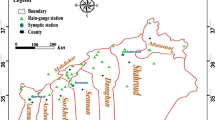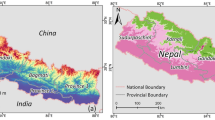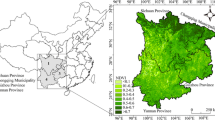Abstract
Drought is a complex combination of natural, physical, and social phenomena. Prolonged drought can result in significant socioeconomic damage. Because the impact of drought varies according to the regional ability to cope with drought, it is necessary to assess the risk of drought by considering regional impact and response capacity. This study aims to improve the conventional drought risk (CDR) assessment method, which typically combines drought hazard and drought vulnerability. We proposed a modified drought risk (MDR) assessment that couples the regional response capacity with the local water supply system, in addition to drought hazard and vulnerability. The application results for South Korea indicated that the MDR coupled with regional response capacity (MDR-RC) was high in the central and northeastern regions, whereas the CDR was high in the southwest regions. A comparison of the regions characterized by high MDR-RC and those that experienced actual drought events and took measures in response indicated that MDR-RC will be useful in drought planning and risk-based decision-making.









Similar content being viewed by others
Data availability
The datasets used or analyzed during the current study are available from the corresponding author on reasonable request.
References
Azam M, Maeng SJ, Kim HS, Murtazaev A (2018) Copula-based stochastic simulation for regional drought risk assessment in South Korea. Water 10(4):359
Bae S, Lee SH, Yoo SH, Kim T (2018) Analysis of drought intensity and trends using the modified SPEI in South Korea from 1981 to 2010. Water 10(3):327
Birkmann J, Cardona OD, Carreño ML, Barbat AH, Pelling M, Schneiderbauer S, Kienberger S, Keiler M, Alexander D, Zeil P, Welle T (2013) Framing vulnerability, risk and societal responses: the MOVE framework. Nat Hazards 67(2):193-211
Brooks N, Adger WN, Kelly PM (2005) The determinants of vulnerability and adaptive capacity at the national level and the implications for adaptation. Glob Environ Chang 15:151–163
Buurman J, Bui DD, Du LTT (2020) Drought risk assessment in Vietnamese communities using household survey information. Int J Water Resour Dev 36(1):88–105
Cardona OD, Van Aalst MK, Birkmann J, Fordham M, McGregor G, Perez R, Pulwarty RS, Schipper ELF, Sinh BT (2012) Determinants of risk: exposure and vulnerability managing the risks of extreme events and disasters to advance climate change adaptation: special report of the intergovernmental panel on climate change. Cambridge University Press, New York, pp 65–108
Choi JR, Kim BS, Kang DH, Chung IM (2022) Evaluation of water supply capacity of a small forested basin water supply facilities using SWAT model and flow recession curve. KSCE J Civ Eng 26:3665–3675
Dabanli I (2018) Drought hazard, vulnerability, and risk assessment in Turkey. Arab J Geosci 11:538
Frischen J, Meza I, Rupp D, Wietler K, Hagenlocher M (2020) Drought risk to agricultural systems in Zimbabwe: a spatial analysis of hazard, exposure, and vulnerability. Sustainability 12(3):752
Hagenlocher M, Meza I, Anderson C, Min A, Renaud FG, Walz Y, Sebesvari Z (2019) Drought vulnerability and risk assessments: state of the art, persistent gaps, and research agenda. Environ Res Lett 14(8):083002
IPCC (2014) Climate change 2014: impacts, adaptation, and vulnerability. Part B: Regional aspects. Contribution of Working Group II to the Fifth Assessment Report of the Intergovernmental Panel on Climate Change. Cambridge University Press, New York
Kim CJ, Park MJ, Lee JH (2014) Analysis of climate change impacts on the spatial and frequency patterns of drought using a potential drought hazard mapping approach. Int J Climatol 34(1):61–80
Kim H, Park J, Yoo J, Kim TW (2015) Assessment of drought hazard, vulnerability, and risk: a case study for administrative districts in South Korea. J Hydro-Environ Res 9(1):28–35
Kim JS, Park SY, Hong HP, Chen J, Choi SJ, Kim TW, Lee JH (2020) Drought risk assessment for future climate projections in the Nakdong River Basin. Korea Int J Climatol 40(10):4528–4540
Kim JE, Yu JS, Ryu JH, Kim TW (2021) Assessment of regional drought vulnerability and risk using principal component analysis and a Gaussian mixture model. Nat Hazards 109:707–724
Liu A, Schisterman EF (2004) Principal component analysis. In: Chow S-C (ed) Encyclopedia of Biopharmaceutical Statistics. CPC Press, New York, pp 1796–1801
Mishra AK, Singh VP (2010) A review of drought concepts. J Hydrol 391(1–2):204–216
Moraru L, Moldovanu S, Dimitrievici LT, Dey N, Ashour AS, Shi F, Fong SJ, Khan S, Biswas A (2019) Gaussian mixture model for texture characterization with application to brain DTI images. J Adv Res 16:15–23
Murgatroyd A, Gavin H, Becher O, Coxon G, Hunt D, Fallon E, Wilson J, Cucelojlu G, Hall JW (2022) Strategic analysis of the drought resilience of water supply systems. Philos Trans Royal Soc 380(2238):20210292
Nam WH, Choi JY, Hong EM (2015) Irrigation vulnerability assessment on agricultural water supply risk for adaptive management of climate change in South Korea. Agric Water Manag 152:173–187
Nasrollahi M, Khosravi H, Moghaddamnia A, Malekian A, Shahid S (2018) Assessment of drought risk index using drought hazard and vulnerability indices. Arab J Geosci. https://doi.org/10.1007/s12517-018-3971-y
Qin QX, Zhang YB (2018) Evaluation and improvement of water supply capacity in the region. J Mgmt Sustainability 8(4):113–124
Rajsekhar D, Mishra AK, Singh VP (2012) Regionalization of drought characteristics using an entropy approach. J Hydrol Eng 18(7):870–887
Rajsekhar D, Singh VP, Mishra AK (2015) Integrated drought causality, hazard, and vulnerability assessment for future socioeconomic scenarios: an information theory perspective. J Geophys Res Atmos 120(13):6346–6378
Russell S, Norvig P (2009) Artificial intelligence: A modern approach, 3rd edn. Prentice Hall, Englewood Cliff, NJ
Shental N, Bar-Hillel A, Hertz T, Weinshall D (2004) Computing Gaussian mixture models with EM using equivalence constraints. Proc Adv Neural Inform Process Syst 16(8):465–472
Van Loon AF, Gleeson T, Clark J, Van Dijk AIJM, Stahl K, Hannaford J, Di Baldassarre G, Teuling AJ, Tallaksen LM, Uijlenhoet R, Hannah DM, Sheffield J, Svoboda M, Verbeiren B, Wagener T, Rangecroft S, Wanders N, Van Lanen HAJ (2016) Drought in the Anthropocene. Nat Geosci 9:89–91
Vogt JV, Naumann G, Masante D, Spinoni J, Cammalleri C, Erian W, Pischke F, Pulwarty R, Barbosa P (2018) Drought risk assessment and managemen: a conceptual framework. Publications Office of the European Union, Luxembourg
Wilhite DA (2000) Drought as a natural hazard: concepts and definitions. Routledge, New York, pp 3–18
Yoo J, Kwon HH, So BJ, Rajagopalan B, Kim TW (2015) Identifying the role of typhoons as drought busters in South Korea based on hidden Markov chain models. Geophys Res Lett 42(8):2797–2804
Yu J, Kim TW, Park DH (2019) Future hydrological drought risk assessment based on nonstationary joint drought management index. Water 11(3):532
Yu JS, Kim JE, Lee J-H, Kim T-W (2021) Development of a PCA-based vulnerability and copula-based hazard analysis for assessing regional drought risk. KSCE J Civ Eng 25(5):1901–1908
Zhao J, Zhang Q, Zhu X, Shen Z, Yu H (2020) Drought risk assessment in China: evaluation framework and influencing factors. Geography Sustainabil 1(3):220–228
Zhou R, Jin J, Cui Y, Ning S, Bai X, Zhang L, Zhou Y, Wu C, Tong F (2022) Agricultural drought vulnerability assessment and diagnosis based on entropy fuzzy pattern recognition and subtraction set pair potential. Alex Eng J 61(1):51–63
Zhu Y, Tian D, Yan F (2020) Effectiveness of entropy weight method in decision-making. Math Probl Eng 2020:1–5
Acknowledgements
We would like to express our gratitude to the editors and reviewers for their helpful comments.
Funding
This research was supported by the grants funded by the Korea Ministry of Interior and Safety (2022-MOIS63-001) and Hanyang University (HY-2022-2893).
Author information
Authors and Affiliations
Contributions
JEK Methodology, Software, Data curation, Writing- Original draft preparation, Validation, Investigation. JHL Conceptualization, Visualization. TWK Supervision, Writing- Reviewing and Editing.
Corresponding author
Ethics declarations
Conflict of interest
The authors declared that they have no conflicts of interest to this work.
Additional information
Publisher's Note
Springer Nature remains neutral with regard to jurisdictional claims in published maps and institutional affiliations.
Rights and permissions
Springer Nature or its licensor (e.g. a society or other partner) holds exclusive rights to this article under a publishing agreement with the author(s) or other rightsholder(s); author self-archiving of the accepted manuscript version of this article is solely governed by the terms of such publishing agreement and applicable law.
About this article
Cite this article
Kim, J.E., Lee, JH. & Kim, TW. Assessment of regional drought risk coupled with drought response capacity considering water supply systems. Stoch Environ Res Risk Assess 38, 963–980 (2024). https://doi.org/10.1007/s00477-023-02608-9
Accepted:
Published:
Issue Date:
DOI: https://doi.org/10.1007/s00477-023-02608-9




